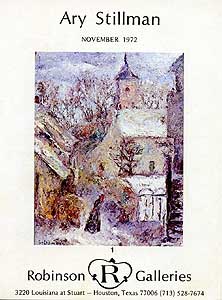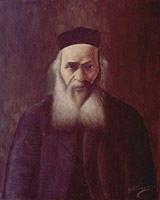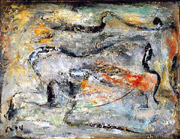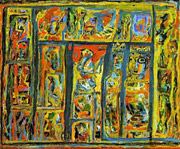
|
The Ary Stillman Green Room, Moores School |
|
P A S T E X H I B I T I O N S
Ary Stillman "Ary Stillman's dedication to painting was never lost and the technical mastery which gave meaning was ever present" wrote the late James Chillman,Jr. in a memorial tribute to the artist, who died in January 1967. It was this dedication, and a consuming desire to search for ever new avenues through which he could express the meaning and spirit of life, that led Stillman into several rather distinct periods in his painting career. We first hear of him in Paris, as an accepted painter in the Paris salons. He held his first one-man show at the Galerie Bernheim-Jeune in 1928. "These are poems simple and direct" wrote Maximilian Gautier. Other critics spoke of "the resonance and profundity of his work", "the rich and extraordinarily luminous colors", the "strange, mystic quality". When Stillman returned to New York in 1934, Emily Genauer was to say of him: "Ary Stillman... recalls the French impressionists. But only if you can imagine them with a dash of Old Master will you have Stillman. His work has a charm, a lyricism, a luminosity which are most exciting." While this phase of Stillman's work was definitely representational it was never photographic. For he was even then concerned with what he later called an "inner reality" rather than a surface reality. This desire to explore deeper the inner reality became constantly more compelling, and the tragedy of World War II with its break-down of the world as h had known it caused him to abandon any attempt to express the surface reality, and to involve himself completely in a world of his own making. Stillman was soon deep in this self-created world, plunging ever farther into the subconscious to call forth half-remembered visions and sensations. The New York press found his work "richly orchestrated", "alive with subtle shimmering harmonies", "non-objective expressions of melodic colors." The New York Times declared, in 1952 that "Ary Stillman's paintings carry abstraction deep into its romantic phase. For him, plastic rhythms are a means of evoking poetic content." In 1955 Stillman returned to Paris and Majorca for eighteen months, and then to Mexico, where he lived for five years, with frequent visits after he took up residence in Houston in 1962. Now he had determined to devote all his energies to painting, without regard to exhibitions or to any activities of the New York scene. And here, as he said, he "invaded the world of fantasy." In the introduction to the catalogue of the Houston Museum of Fine Arts Ary Stillman retrospective in 1972, Richard Teller Hirsch writes of this period: "Ary had responded to the Sienese, the early Catalonians, and living in Mexico or within his studio in Houston, he pondered Mayan riddles. He worked to say powerful things evoked from strange dimensions of time, unmindful of modish galleries. The Mayas (and the Incas) haunted him; his brush moved boldly in answer to echoes within his mind as his intuition evoked them." Thus we find we can divide Ary Stillman s work loosely into three periods — representational, abstract, and fantasy. Throughout, however, we find the same painter — idealist, individualist, romantic, mystic, eager for life and eager to express through painting that which he felt and he dreamed.
|
| © 2008 The Stillman-Lack Foundation, All text and images on this site may not be published, broadcast, or distributed in any form without the prior written permission of The Stillman-Lack Foundation. |



